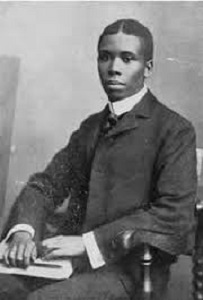De Amerikaanse dichter en schrijver Paul Laurence Dunbar werd geboren op 27 juni 1872 in Dayton, Ohio. Dunbar was de zoon van voormalige slaven uit Kentucky. Hij volgde de middelbare school in Dayton; daar was hij de enige Afro-Amerikaan in zijn klas. Een van zijn klasgenoten was Orville Wright, voor wiens familie Pauls moeder werkte. Al tijdens zijn schooltijd gaf hij voor het eerst blijk van zijn literaire talent. Hij was lid van de literaire kring en uitgever van de schoolkrant. Met de steun van de gebroeders Wright was hij in staat om zijn eerste krant “The Dayton Tattler” te publiceren. Na de middelbare school werkte hij, gedwongen door zijn financiële situatie, als liftboy. Op een bijeenkomst van de westerse Vereniging van Schrijvers in 1892 werd hij uitgenodigd door een vroegere leraar om gedichten voor te dragen en hij maakte daarmee zoveel indruk dat hij een aanbevelingsbrief van de beroemde dichter James Whitcomb Riley ontving. In hetzelfde jaar publiceerde hij zijn eerste dichtbundel “Oak and Ivy”. Nadat hij verhuisd was naar Chicago, ontmoette hij Frederick Douglass, die hem omschreef als “the most promising young colored man in America.” Dunbars gedichten verschenen in bekende kranten als The New York Times. Met zijn tweede dichtbundel “Majors and Minors” – Majors staat voor tekst in het standaard Engels en Minors voor teksten in dialect – was hij zo succesvol dat hij uitgenodigd werd voor een zes maanden durende lezingentour door Engeland. Na zijn terugkeer in Amerika kreeg hij een baan bij de Library of Congress in Washington. Daar ontmoette hij en trouwde hij met de schrijfster Alice Ruth Moore. In Washington ontstond een roman en twee dichtbundels. Ook schreef hij in deze tijd enkele libretti. Toen bij Dunbar in 1898 tuberculose geconstateerd werd keerde hij terug naar Dayton en wijdde zich uitsluitend aan het schrijven en aan lezingen. In 1902 scheidde hij van zijn vrouw. Dunbar was een van de eerste zwarte dichter die in de Verenigde Staten erkenning gekregen.
The Corn-Stalk Fiddle
When the corn’s all cut and the bright stalks shine
Like the burnished spears of a field of gold;
When the field-mice rich on the nubbins dine,
And the frost comes white and the wind blows cold;
Then its heigho fellows and hi-diddle-diddle,
For the time is ripe for the corn-stalk fiddle.
And you take a stalk that is straight and long,
With an expert eye to its worthy points,
And you think of the bubbling strains of song
That are bound between its pithy joints—
Then you cut out strings, with a bridge in the middle,
With a corn-stalk bow for a corn-stalk fiddle.
Then the strains that grow as you draw the bow
O’er the yielding strings with a practiced hand!
And the music’s flow never loud but low
Is the concert note of a fairy band.
Oh, your dainty songs are a misty riddle
To the simple sweets of the corn-stalk fiddle.
When the eve comes on and our work is done
And the sun drops down with a tender glance,
With their hearts all prime for the harmless fun,
Come the neighbor girls for the evening’s dance,
And they wait for the well-known twist and twiddle,
More time than tune—from the corn-stalk fiddle.
Then brother Jabez takes the bow,
While Ned stands off with Susan Bland,
Then Henry stops by Milly Snow
And John takes Nellie Jones’s hand,
While I pair off with Mandy Biddle,
And scrape, scrape, scrape goes the corn-stalk fiddle.
“Salute your partners,” comes the call,
“All join hands and circle round,”
“Grand train back,” and “Balance all,”
Footsteps lightly spurn the ground,
“Take your lady and balance down the middle”
To the merry strains of the corn-stalk fiddle.
So the night goes on and the dance is o’er,
And the merry girls are homeward gone,
But I see it all in my sleep once more,
And I dream till the very break of dawn
Of an impish dance on a red-hot griddle
To the screech and scrape of a corn-stalk fiddle.

Paul Laurence Dunbar (27 juni 1872 – 9 februari 1906)
